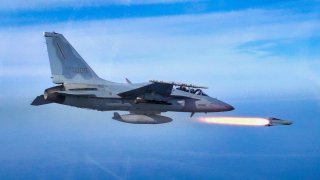KAI FA-50: South Korea Might Have Built the Best 'Cheap' Fighter Ever
South Korea, transitioning from reliance on U.S. military hardware to self-reliance, has emerged as the world's 8th largest weapons exporter, pitching the KAI FA-50 light fighter to various countries, including Thailand.
Summary: South Korea, transitioning from reliance on U.S. military hardware to self-reliance, has emerged as the world's 8th largest weapons exporter, pitching the KAI FA-50 light fighter to various countries, including Thailand. Competing against Boeing's F-16 and SAAB's JAS-39 Gripen for a high-profile contract, the FA-50 is marketed as a cost-effective, versatile alternative. With Poland and Malaysia already showing interest and Thailand considering replacing older F-16s with newer models, the FA-50's appeal lies in its cost-efficiency and capability. The Royal Thai Air Force (RTAF), planning to modernize its fleet, sees the FA-50 as a strong candidate due to its similar armaments to the F-16 and Gripen, reduced training and maintenance costs, and strategic partnership potential with South Korea. A decision on the procurement is expected soon, with cost and strategic alignments being key considerations.
Here Comes the FA-50 'Cheap' Fighter
The Republic of Korea – or South Korea as it is more commonly known – has successfully transitioned from being reliant on the United States for military hardware to being self-reliant, and in a short time has become the world's 8th largest weapons exporter. It is now pitching the Korean Aerospace Industries (KAI) FA-50 light fighter to Thailand, competing for a high-profile contract against such proven aircraft as Boeing's Block 70 F-16 Fighting Falcon and SAAB's JAS-39 Gripen.
KAI has already attracted interest from Poland and Malaysia, promoting the FA-50 as a cost-effective and capable alternative to more traditional fighter aircraft. The first two FA-50s arrived in Poland last November. The Royal Thai Air Force (RTAF) is now weighing its options as it seeks to modernize and match the military strength of its neighbors – notably China.
The RTAF is planning to decommission a dozen older F-16s in service with its Squadron 102, at Wing 1. The Thai air service also operates the Swedish-made JAS-39 and previously acquired six FA-50s, as well as eight T-50 Golden Eagle trainers from KAI.
The South Korean aerospace firm has touted the FA-50 as being as versatile as the F-16 yet half the cost. During a visit to South Korea last month, Thai Defense Minister Sutin Klungsang met with KAI CEO Kang Goo-young, and the pair discussed the possible acquisition of the aircraft.
A committee tasked with determining which aircraft will be acquired will release its decision in May or June of this year. However, funding remains a primary issue, with a significant investment required for procurement, training, and long-term maintenance. An additional issue for Bangkok will be in its balancing strategic partnerships, and it may seek closer ties with regional partner South Korea.
From Trainer to Light Fighter
The KAI FA-50 is based on the T-50, which was adapted from the F-16 as an indigenous trainer aircraft capable of supersonic flight to train pilots for the KF-16 and F-15K. Like the F-16, it is a single-engine, multirole two-seat fighter.
As the most advanced version of the T-50, it possesses more internal fuel capacity, enhanced avionics, a longer radome, and a tactic datalink. It is reported to be equipped with a modified Israeli EL/M-2032 pulse-Doppler radar with Korean-specific modifications by LIG Nex1. It is powered by a General Electric F404-GE-102 turbofan engine capable of a thrust up to 17,700 LBF and speeds of around Mach 1.5.
The FA-50 can carry similar armament to the F-16 Fighting Falcon and JAS-39 Gripen, while it is also capable of carrying most of the South Korean Air Force's missiles, bombs, and other munitions. It is equipped with a 20mm cannon.
There have been reports that KAI was developing a single-seat version of the FA-50 to enhance its combat potential, including air-to-air and air-to-ground strikes.
FA-50: Low Cost Alternative
To date, 138 KAI FA-50s have been exported to Malaysia, the Philippines ( where one scored a "kill" against the F-22 in an aerial exercise), Poland, and Thailand.
As the RTAF considers its options, price could be its biggest factor. In addition to the upfront costs, it is a combat version of the T-50, which will reduce the learning curve for both pilots and maintenance crews. Its lower cost per flight hour could allow pilots to have more time in the cockpit.
All these factors could help make the FA-50 a viable alternative to proven warbirds.
Author Experience and Expertise: Peter Suciu
Peter Suciu is a Michigan-based writer. He has contributed to more than four dozen magazines, newspapers, and websites with over 3,200 published pieces over a twenty-year career in journalism. He regularly writes about military hardware, firearms history, cybersecurity, politics, and international affairs. Peter is also a Contributing Writer for Forbes and Clearance Jobs. You can follow him on Twitter: @PeterSuciu.
You can email the author: [email protected].


